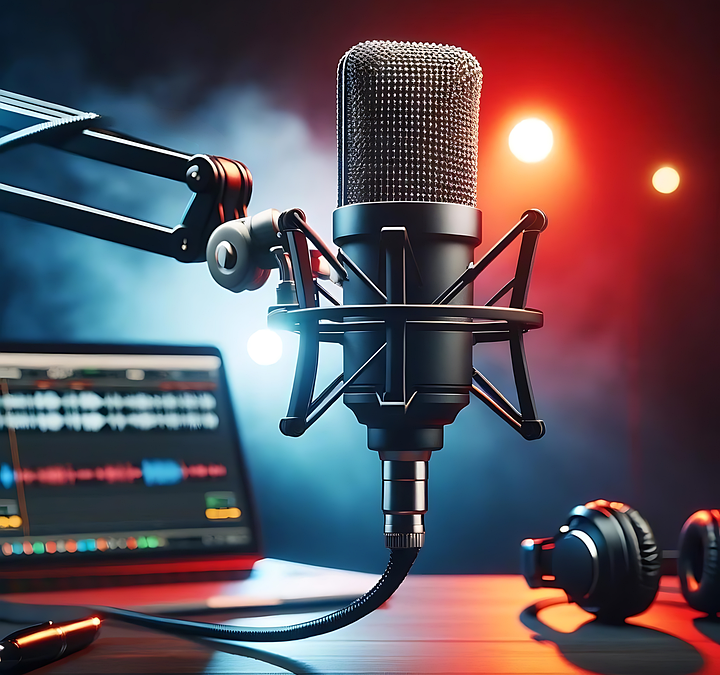Podcasting has become one of the most popular ways to share ideas, tell stories, and build an audience. While great content is essential, high-quality audio can make or break a podcast. A professional recording space at home can elevate your podcasting game, improve listener experience, and boost your credibility. In this guide, we’ll walk you through everything you need to know about setting up a professional podcast studio at home, from choosing the right space to selecting the best equipment.
1. Choosing the Right Space
Before purchasing equipment, you need to select the ideal recording space in your home. Here are some factors to consider:
- Quiet Environment: Choose a room away from noisy areas like the kitchen, laundry room, or street-facing windows.
- Minimal Echo and Reverb: Large, empty rooms create unwanted echoes. Opt for a smaller space with carpets, rugs, and furniture to help absorb sound.
- Controlled Lighting: If you plan to record video podcasts, consider a space with natural lighting or room for proper lighting setups.
2. Soundproofing and Acoustic Treatment
Soundproofing prevents external noise from entering your studio, while acoustic treatment improves the sound quality inside the space. Here’s how to tackle both:
Soundproofing Tips:
- Use weather stripping on doors and windows to seal gaps.
- Add thick curtains or blankets over windows to block outside noise.
- Place a draft stopper under the door to reduce sound leakage.
Acoustic Treatment Tips:
- Install foam panels or fabric-covered acoustic panels on walls to absorb sound reflections.
- Place a rug or carpet on the floor to reduce reverb.
- Use bookshelves or curtains as natural sound absorbers.
3. Essential Podcasting Equipment
Now that your space is optimized for sound, it’s time to select the right equipment.
Microphone:
A quality microphone is crucial for professional-sounding audio. Here are two main types:
- Dynamic Microphones: Best for blocking background noise, great for untreated rooms (e.g., Shure SM7B, Rode PodMic).
- Condenser Microphones: Offer high sensitivity and rich sound but pick up more background noise (e.g., Audio-Technica AT2020, Rode NT1-A).
Audio Interface or Mixer:
An audio interface connects your microphone to your computer and improves sound quality (e.g., Focusrite Scarlett 2i2, Rode AI-1). If you plan to use multiple microphones, a mixer like the Rodecaster Pro 2 offers greater control over your audio levels.
Headphones:
Use closed-back headphones to monitor your recordings and eliminate feedback (e.g., Audio-Technica ATH-M50X, Sony MDR-7506).
Pop Filter and Boom Arm:
- A pop filter reduces plosive sounds (p, t, b) and improves clarity.
- A boom arm holds your microphone in place and reduces desk vibrations.
Computer and Recording Software:
- A reliable computer or laptop is necessary for editing and recording.
- Popular recording software includes:
- Audacity (Free) – Great for beginners
- Adobe Audition (Paid) – Professional-grade editing
- GarageBand (Free for Mac Users) – User-friendly option for Apple users
4. Video Recording Setup (Optional)
If you plan to create video podcasts, consider adding a camera and lighting setup:
- Camera: DSLR (Canon EOS M50), webcam (Logitech Brio), or smartphone with a tripod.
- Lighting: Use a ring light or softbox lighting for a professional look.
- Backdrop: Consider a clean wall, bookshelf, or custom backdrop to create a professional aesthetic.
5. Recording and Editing Tips
With your setup ready, follow these best practices to get the best audio quality:
- Record in a quiet time of day (avoid rush hour traffic or family activities).
- Speak 6–12 inches from the microphone for optimal clarity.
- Use a script or outline to stay on track during recordings.
- Reduce background noise using software tools like Krisp or Adobe Podcast Enhance.
6. Budget-Friendly Setup Options
If you’re on a budget, here are some cost-effective alternatives:
- Microphone: Audio-Technica ATR2100x or Samson Q2U
- Audio Interface: Behringer UM2 or use a USB mic
- Pop Filter & Boom Arm Bundle: Available on Amazon
- Editing Software: Audacity (free) or GarageBand (free for Mac users)
7. Testing and Improving Your Setup
Once your studio is ready, test your setup:
- Do a trial recording to check sound quality.
- Make adjustments to microphone placement, acoustic treatment, or software settings.
- Ask for feedback from friends or fellow podcasters to fine-tune your setup.
Final Thoughts
Creating a professional podcast studio at home is an investment in the quality and success of your podcast. By choosing the right space, optimizing acoustics, and selecting essential equipment, you can achieve studio-quality sound from the comfort of your home. Whether you’re a beginner or a seasoned podcaster, following these steps will ensure a smoother, more professional podcasting experience.
Need help launching your podcast?
Schedule a Free Podcast Strategy Call TODAY!


Recent Comments